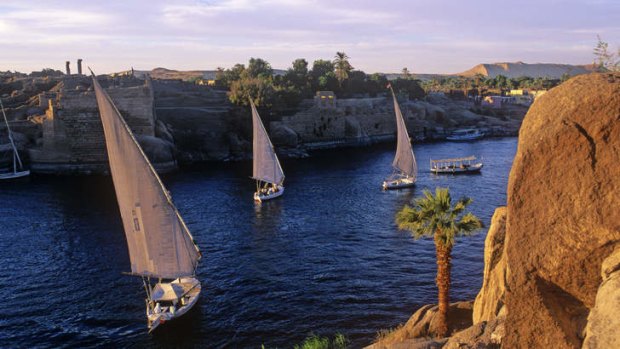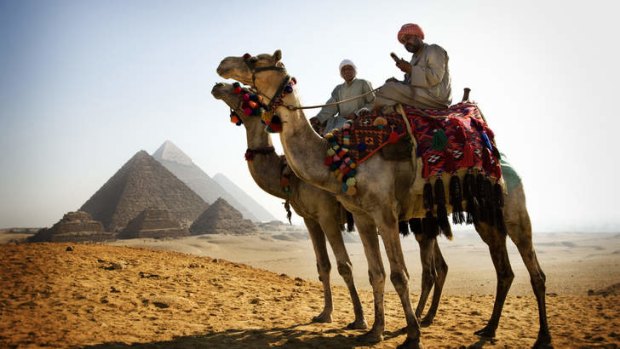
Take a Giza: feluccas on the Nile.Credit: Corbis
With tourism at a low, the advantages of visiting Egypt now are many, writes Michael Gebicki.
It's mid-afternoon on the Nile and I am watching the scenery glide by from the top deck of the Royal Lily, in a warm breeze that tugs at my shirt. Every couple of kilometres we pass a village of flat-roofed mudbrick houses shaded by date palms. Between each village is a luscious green sandwich of wheat and lucerne fields set against a backdrop of toasted sandstone hills. Ox carts plod and creak in a nimbus of dust. It's time for asr, the afternoon prayer, and the call "Allahu Akbar" echoes from minarets, sending rooks flapping into the sky. We are passing through scenery that would be familiar to Moses.
Yet Egypt teeters on the brink of a cataclysm.

Camels at Giza.Credit: Getty Images
"President Anwar el-Sadat and I, separately considering the Egyptian capital city of Cairo, recently arrived at the same conclusion: it was about to explode."
That was Jan Morris writing 35 years ago, and nothing much has changed. Chaos is a natural condition in Egypt. In Cairo, half-finished buildings line the city's thoroughfares, concrete shells with metal reinforcing rods poking skywards. For two days I tour the city, the largest in Africa and the Middle East, without seeing a single traffic light. Traffic is a mess, roads are clogged, there are no such thing as lanes, pedestrians weave, cars stop anywhere to pick up and drop off, horns blare constantly.
Yet to mistake this permanently chaotic condition for danger is to fall prey to the blindness that keeps the wider world fearful and away. In fact, there has actually never been a better time to visit Egypt. When revolutionary spasms shook the country in 2011, tourism evaporated. Even though foreigners were never targeted during the overthrow of the Mubarak regime, the scenes of burning vehicles and chanting mobs worked their mischief.
I'm travelling with Bunnik Tours, an Australian, family-owned tour operator with years of expertise in the Middle East, and a special level of commitment to its clientele. When the first stirrings of the 2011 revolution swept over Egypt, managing director Dennis Bunnik hopped on a plane, flew to Egypt where the company had three groups touring at the time, assembled them in Cairo and had them all out within a couple of days. This was several days before the Australian government chartered a Qantas aircraft and evacuated other Australian tourists who had been left stranded.
Bunnik is with us for the first few days of our own journey, on one of his frequent return visits to see with his own eyes the situation on the ground. For anyone at all nervous about visiting Egypt in its present condition, that's a confidence boost.
We're an all-Australian tour group, 17 in number, aged 50-something for the most part, although some are at either end of the age spectrum.
The lack of crowds is a bonus. In the Tutankhamun room in the Egyptian Museum I am free to linger over the golden face of the young pharaoh. On my Nile cruise, the Royal Lily is perhaps one-quarter full, and many other of the hotel boats are mothballed. At Karnak, one of the supreme wonders of the Middle and New kingdoms usually packed with tour groups, I can click away with my camera without having to wait for the man in the Chicago Bulls T-shirt to vacate the frame. At every stop I am given a better hotel room - a view of the pyramids at Le Meridien in Giza, overlooking feluccas on the Nile at the Movenpick Resort at Elephantine Island in Aswan, and every souvenir seller, every driver, every waiter and hotel bag carrier is exceedingly glad that I'm here.
What brings you here, of course, is history, heaps of it. Egyptian history is one of the world's great epics, tailor-made for Hollywood. More than 4500 years have passed since the Great Pyramid was hoisted block by block into the sky at Giza, where it remained the world's tallest man-made structure until old St Paul's Cathedral in London more than 35 centuries later.
The scale of ancient Egypt is monumental - the columns, the obelisks, the statues, the Avenue of Sphinxes at Karnak, the gigantic statues of Ramesses II and his queen, Nefertari, at Abu Simbel, the Hypostyle Hall of Amenhotep III at the Temple of Luxor - and not just big but exquisitely detailed. Ancient Egypt raised the arts of bas relief and intaglio to a height never seen before and rarely since, based on a rich and evocative mythology constructed by a priestly caste who created gods and goddesses to explain the rising of the sun and the journey of the soul into the afterlife. Apart from the pyramids and the sphinx - half-day required - the temples and tombs are what remains of the glory that once was, and you're going to be spending plenty of time in them.
It is the Valley of the Kings that provides one of the richest experiences. Sealed off from sun and wind, the walls of the underground tombs are covered with vivid frescoes painted with red ochre, sulphur yellow, black and a demure blue, depicting a rich culture that liked music and food and straight lines and went in for wigs in a big way.
We've seen it all before in the pages of encyclopaedias and breathless documentaries, the pyramids, the temples, the paintings, yet it would be hard to come here and not discover something that sets the heart romping. But the story of Egypt is the story of the Nile. It is this river that has made life and civilisation possible in Egypt. Until the building of the dams at Aswan the river would flood every year, delivering a rich cargo of fertile silt to the farms along its banks. Extending from the river is a filigree of canals and capillaries that irrigate fields of wheat, cotton, rice and barley and the vineyards, citrus groves and pomegranate orchards along its banks. Where the irrigated fields stop, a wilderness of sand and rock begins.
Even gravity and the wind conspire to assist navigation along the Nile. While the river flows from south to north, the prevailing wind blows the opposite way, the single fact that made it feasible to transport the giant blocks used to build the temples and to unify all of Egypt as a single country. These days the three-day cruise on the Nile between Luxor and Aswan is the float-tank chapter in the Egyptian experience, a slow and languid voyage past the ribbon of greenery that rescues Egypt from the parched sands of the Sahara.
In Luxor late one afternoon we set off in caleches for a ride that ends among the crowded stalls of the souk. The caleche is a kind of metaphor for Egypt. At first sight it looks jaunty and fun, a big-wheeled carriage, elegant and showy with red-rimmed wheels and a glossy black body with a folding hood like an old-fashioned pram. Silvery metal cut-outs decorate its sides and dangle from its hood for the amusement of its passengers. On closer acquaintance, though, the seat is lumpy, the hood dusty and cracked and one wheel might turn so lopsidedly on the axle that it looks as though the whole thing is about to fall off. It doesn't matter though. The driver will crack his whip, the horse will gallop, you'll clatter along the road and you will eventually get to where you want to go, leaving you laughing on the kerb, a little relieved but never for a moment regretting that you made the journey.
Michael Gebicki was a guest of Bunnik Tours.
FIVE MUST-SEE SITES
Abu Simbel Carved from a mountainside deep in Egypt's Nubian region and moved to save it from the waters of Lake Nasser, this imposing temple commemorates the victory of Ramesses II and his queen, Nefertari, in the Battle of Kadesh.
Karnak Temple Biggest religious complex of the ancient world, an architectural masterpiece constructed over 15 centuries and reflecting the power and engineering mastery of the Middle Kingdom.
Valley of the Kings Still stunningly fresh, the frescoes of these underground tombs celebrate a refined and artistic culture.
Kom Ombo Set on the banks of the Nile, this temple is dedicated to the crocodile god, Sobek, with outstanding examples of hieroglyphs and carved columns; mummified crocodiles provide weird mementoes in the adjacent museum.
Pyramids of Giza and the Sphinx Overwhelming in scale, these monumental constructions challenge the imagination.
FAST FACTS
Getting there Singapore Airlines has a fare to Cairo for about $1570, low-season return from Melbourne and Sydney, including tax. Fly to Singapore (about 8hr) then to Cairo (about 14hr, including transit time in Dubai); see singaporeair.com. Australians require a visa for a stay of up to 30 days.
Touring there Bunnik Tours' 17-day Egypt in Depth tour travels the full length of the country, from Alexandria on the Mediterranean Sea to Aswan and Abu Simbel in Upper Egypt. Including accommodation, most meals, all flights and travel within Egypt and guided daily tours as well as return flights from Australia, the price starts from $5395.
More information Bunnik Tours, bunniktours.com.au.
Sign up for the Traveller Deals newsletter
Get exclusive travel deals delivered straight to your inbox. Sign up now.